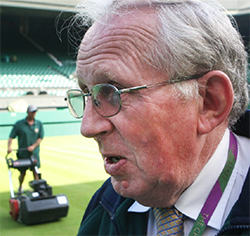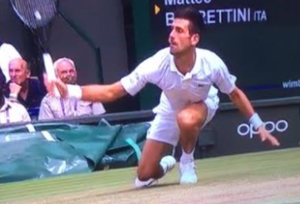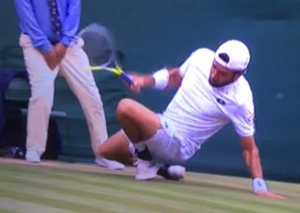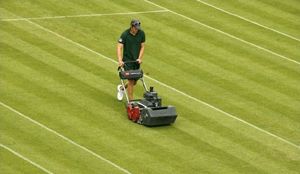Images of Falling Players Pull Groundskeepers Back Into Spotlight
VIEW AND DOWNLOAD WORLD TENNIS GAZETTE VOL. 15 NO. 1
By JOHN MARTIN

credit: John Martin
WIMBLEDON (VIA SAN DIEGO) – Images of falling bodies, grimacing faces, and prone players have ignited the most serious discussion of the All England Club’s celebrated grass courts in more than a decade.
“To be honest, I don’t remember falling this many times,” said top-seeded Novak Djokovic after his first-round match. “It’s quite slippery. Whether it’s because the roof was closed or it was raining quite a lot in the last few days, I don’t know.”
When Serena Williams fell and injured a hamstring muscle, withdrawing from play after only six games, the club defended its court preparations as meeting its traditional high standards
“Each grass court is checked by the Grand Slam Supervisors, Referee’s Office and Grounds team ahead of play commencing,” said a club statement, “and on both days of the Fortnight they have been happy with the conditions and cleared the courts for play.”
Players slipped and fell repeatedly over the two weeks. Champion Novak Djokovic and finalist Matteo Berretini were among several who tumbled, including Andy Murray and Sebastian Korda.

Screen Capture

Screen Capture
Wimbledon officials insisted that the grass was mowed as usual every morning to a height of 8 millimeters
What many fans may not realize is how closely the lawns are monitored and pampered both before and after the yearly Wimbledon Championships.
In 2010, the head groundskeeper, Eddie Seaward, described his efforts to meet requests by clay court officials to slow down play by a fraction of a second.
In an interview for The New York Times, he told me he faced a disturbing challenge.
“The talk was very much about ‘grass court tennis is finished’ because it was all hard, bang, crash, wallop, ” Seward said.
Coaches consulted in the 1990s by the All England Club asked that the surface be adjusted to accommodate a different style of play.
“They said, actually, if you could slow the ball down by a tenth of a second, from one end to the other,” Seaward said, “that’s what they needed.”
In its way, this barely perceptible lengthening of points, Seaward suggested, helped prevent the elimination of grass-court tournaments from the international circuit, a prospect that he said loomed in the 1990s.
Part of his response, Seaward explained, was to employ the Sports Turf Research Institute, which plants test beds about 200 miles to the north in West Yorkshire. There, it subjects experimental grasses to tennis-style poundings for two weeks at a time to replicate the Wimbledon competition.
In 2010, nine days before his quarterfinal upset defeat by Tomas Berdych, Roger Fed-erer was convinced that the grass at the All Eng-land Club no longer deserved its reputation. for speed:
“Obviously, they’re not the fastest courts anymore.”
Seward saw it differently.
“The ball comes off the same speed, but I think it comes a little bit higher,” he said. “So you get a little bit higher bounce.”

credit: Glyn Kirk/Agence France-Presse — Getty Images
The difference is about a tenth of a second, insignificant to fans and ordinary players, but not to the world’s top competitors.
They noticed that the soil, seeded with a special strain of rye grass, allowed the sun to dry the ground more deeply. This changed the speed of play.
Twenty years earlier, the ball traveled from Stefan Edberg’s racket to Boris Becker’s racket a tenth of a second faster. So Berdych had a split second longer to read Federer’s serves. Of course, Federer had the same benefit.
Seaward insisted that this slight slowdown benefited the sport.
“You’re getting the longer rallies,” Seaward told me in 2010. “You’re getting different people winning the court championship.” Indeed, clay-court specialists, who once shunned Wimbledon, were lured back.
Now, in a new decade, Wimbledon faces a new challenge: Adjust the grass to make it less slippery — and safer — for the world’s finest players. This solution likely lies in those test beds of West Yorkshire.